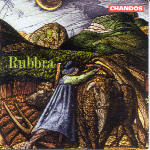However listenable they may be, Rubbra’s early symphonies–up through No. 4–suffer from the typical post-classical-era “finale problem”. Relentlessly contrapuntal in style, a bit humorless, often densely and somewhat colorlessly orchestrated yet full of fine music, no one so far, neither Richard Hickox nor his various predecessors on Lyrita, has completely succeeded in making the case for them as a whole. The exception is the Second Symphony, a finely balanced work that Adrian Boult first championed, and one that gives Hickox and his band a chance to shine as well. However, starting with the warmly genial Symphony No. 5 (first recorded by Barbirolli in the early 1950s in an excellent performance recently reissued by EMI), it’s pretty smooth sailing–save for the garrulous, choral No. 9, which is definitely an acquired taste.
In general, the more interesting the musical textures the more successful Hickox’s interpretations become, and so he does Nos. 5-11 quite well. In No. 6, for example, his rhythmic freshness clearly scores over previous recordings, the opening allegro revealing its strong connection to the first movement of Sibelius’ Third. If there are problems, they lie with some occasionally less-than-alluring string playing from the BBC National Orchestra of Wales (partly a function of Rubbra’s excessive reliance on them) rather than with Hickox’s shaping of this or that movement, though now that Lyrita has gone and the collector has few options, I wouldn’t make too much of this. Chandos’ engineers have wisely avoided bathing the orchestra in an excess of resonance, and present the music with admirable clarity. This set represents a fine achievement in support of a worthy cause, and it makes sense for Chandos to gather the cycle together in a box. If you enjoy one, you’ll want them all. [9/23/2001]
































